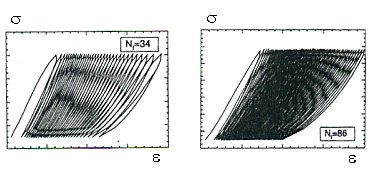| Home | About Us | FEA Tools | News | | Service Life Prediction |

|
|
Fatigue is one of the most ancient topics in strength of materials. It was first realized in the middle of the nineteenth century that engineering components and structures often fail when subjected to repeated fluctuating loads whose magnitude is well below the critical fracture load under monotonic loading. Early studies in fatigue have not accounted for the details of the failure mode nor for the existence and growth of initial imperfections in the material, but have tried to determine the fatigue life in terms of global measurable quantities, like stress, strain, mean stress, etc. Fatigue failure process of an engineering structure is generally divided into three stages: 1. crack initiation or nucleation from material imperfections, 2. stable crack growth, and 3. unstable crack propagation until catastrophic failure. Fatigue limit is the critical stress of a structure under fatigue loading, and fatigue life refers to the number of load cycles that a structure survived until it reached the final failure. In case more than one cyclic loads are added on the structure in a subsequential manner, fatigue life is counted as the total number of cycles.
Paris law applies to low cycle fatigue prediction, which indicates that the rate of crack growth at each cycle is a power function of the corresponding stress intensity factor. A modified Paris law suggests to replace stress intensity factor by strain energy release rate to make the theory applicable for elastic-plastic materials. Multi-axial stress influences fatigue of material in various ways. Fatigue of mild steels and many alloy steels is governed by Von Misses stress when crack growth is represented mostly as the development of the crystal grain dislocation. The volume stress or hydraulic pressure plays an important role on porous materials. Frequency of loading affects fatigue life and fatigue limit when it is reasonably high. For some materials, such as steels, load frequency does not influence fatigue behavior before it reaches a few hundred hertz. When it starts to be a significant concern, higher frequency loading normally elevates fatigue life for low cycle fatigue but influence high cycle fatigue and fatigue strength in different ways and is strongly dependent on environmental conditions, such as existence of aggressive agents. |
|
|
|
| Links to Related American Societies: ASME | ASCE | IEEE | SEM | ISSMGE | ASTM |
To save your time and budget, let us handle your mechanical analysis problems.
© Copyright Simucode.com. All rights reserved.
All logos, names, and trademarks are properties of their respective companies.
 Low cycle fatigue (LCF) refers to the situation when the stage of stable crack growth
becomes dominant, and high cycle fatigue (HCF) indicates that crack initiation stage takes most of the cycles before
the structure fails. High cycle fatigue life is usually predicted by stress, strain, mean stress, etc., and low cycle
fatigue is better evaluated by fracture mechanics based crack propagation criteria.
Low cycle fatigue (LCF) refers to the situation when the stage of stable crack growth
becomes dominant, and high cycle fatigue (HCF) indicates that crack initiation stage takes most of the cycles before
the structure fails. High cycle fatigue life is usually predicted by stress, strain, mean stress, etc., and low cycle
fatigue is better evaluated by fracture mechanics based crack propagation criteria.